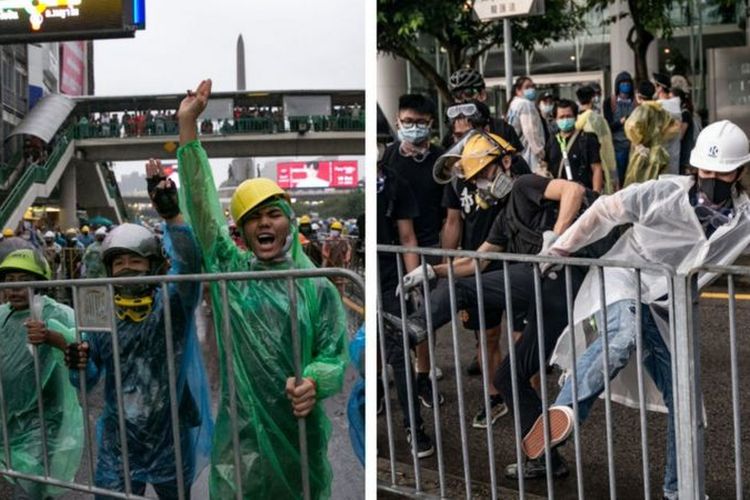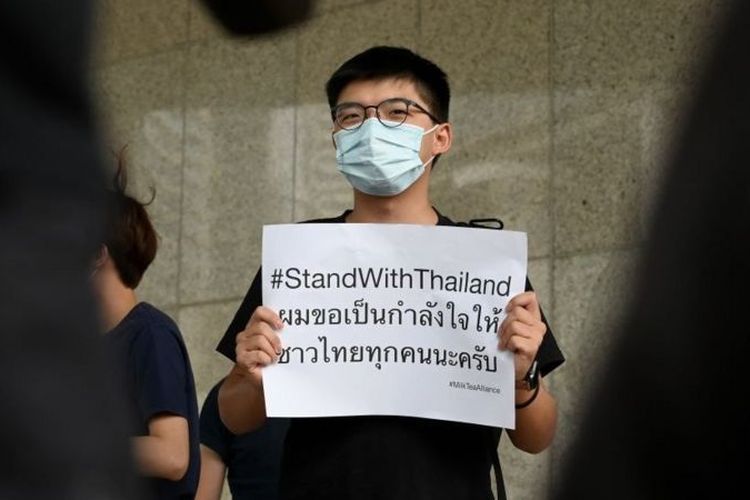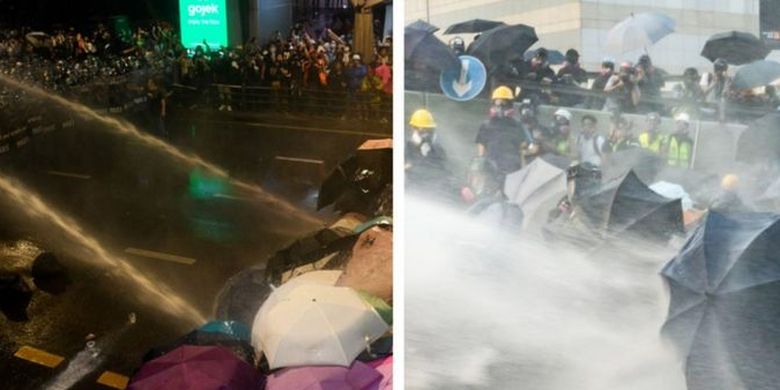BANGKOK, KOMPAS.com – Thai democracy activists have increasingly copied the tactics used by protesters in Hong Kong against the ban on assembly, after months of protests targeting the prime minister and king.
When protesters in Bangkok used umbrellas to protect themselves from tear gas that was fired for the first time on Friday (10/16/2020), it was very much like the anti-government demonstrations that rocked Hong Kong last year.
From helmets to gas masks to flashmobs to hand signs, the Thai student movement appears to draw on the experiences of young Hong Kong activists in their struggle for change.
Here are three things that happened in the Thai protests, which are similar to what happened in Hong Kong.
Also read: The pro-Royal Thai masses took to the streets, clashed with students
Movement without leaders: “We are all leaders today”
After many of the demonstrators’ leaders were arrested last week, the activists changed tactics.
“They think arresting the leaders will stop us,” said Pla, a 24-year-old demonstrator, told thousands of protesters at the Bangkok Victory Monument on Sunday (18/10/2020).
“(Arrest) is pointless. We are all leaders today.”
Although there are several figures who are considered leaders, decision-making is carried out by involving the mass of protesters, usually using forums online and Telegram message exchange applications. They then gathered in large numbers quickly.
Also read: Thai Ultimatum PM Prayut Chan-o-cha to Resign in 3 Days
In Thailand, Telegram usage has skyrocketed in recent days.
Protesters have used it to coordinate rallies since the government banned political gatherings of more than four people last week.
A group started by Free Youth, one of the main action societies, had 200,000 followers on Telegram shortly after launch.
Thai authorities responded by ordering internet providers to block the app.
Many Thais join Telegram as observers, but active members use the means to devise strategies – from locating demonstrations to informing each other about the whereabouts of the police.
Like Hong Kong protesters, Thai activists have decided in a referendum.
Also read: Failing to reduce demonstrations, Thailand’s PM withdraws emergency decree
On Monday (19/10/2020), Free Youth’s main Facebook page asked supporters for their opinion on whether they should take a break.
If they choose to take a break, they are asked to reply with emoticons “care“If they want to continue the demo, they are asked to reply with emoticons.”wow“.
Consumers have decided to continue the demonstration.
 The demonstrations in Thailand (left) and Hong Kong (right) did not have a centralized leader.-The Thai protesters are now trying to “stay as level as possible, making open leadership replaceable”, said Aim Sinpeng, a political scientist at the University of Sydney.
The demonstrations in Thailand (left) and Hong Kong (right) did not have a centralized leader.-The Thai protesters are now trying to “stay as level as possible, making open leadership replaceable”, said Aim Sinpeng, a political scientist at the University of Sydney.
“This is very different from the protests in the past in Thailand, which tended to be personalized around leaders who were often people of influence.”
Use of tags #everybodyisaleader (all are leaders) have flourished on social media in recent days, in an attempt to “restart the movement … to protect ourselves from state persecution”, said Dr Aim, whose research focuses on digital politics in Southeast Asia.
Also read: Thai PM Plans to Immediately Revoke Emergency Decree amid widespread chaos
New protest language: Hand signs and “jungle phone”
Over the weekend a new language develops on the streets of Bangkok City, something that previously happened in Hong Kong.
To signal that they needed a helmet, the activists raised their hands in a triangle above their heads.
By crossing their fingers, they indicate someone is injured.
Rotating the index finger counterclockwise is a warning to disperse.
????????????? #????17???? pic.twitter.com/GUjtTanR3f
– ?????????????????????????????????? (@ suzu17_) October 17, 2020
The clever use of hand gestures was first seen in Hong Kong. The gesture is indispensable for protesters communicating among a large crowd.
Thai activists have adopted the use of this hand gesture as well as creating local signals that are shared via infographics on social media.
Since their loudspeakers were confiscated, activists have used other innovative communication methods, said Wasana Wongsurawat, a history professor at Chulalongkorn University.
At a protest in Bangkok on Saturday, he witnessed activists deploying what he describes as “jungle telephones” to signal the arrival of police or request necessary tools, such as umbrellas for those on the line. front of protest.
“Someone will shout ‘water cannons are coming’. Then the people in the crowd start repeating the sentence. Within two minutes, the message spreads from one side of the demonstration to the other,” Dr Wasana told BBC.
He added that the protest was dispersed before the equipment arrived.
 Water cannons were used to disperse Thai demonstrators.-Beyond the limit: #StandWithThailand
Water cannons were used to disperse Thai demonstrators.-Beyond the limit: #StandWithThailand
The protests in Thailand and Hong Kong are rooted in different local problems, but activists see the similarities.
In Thailand, protesters are demanding the resignation of Prime Minister Prayuth Chan-ocha, a former coup leader who became prime minister last year after general elections, the results of which are disputed.
They also pressed for reforms of the country’s strong monarchy, something unprecedented for an institution protected from legal criticism.
In Hong Kong, activists also demanded the resignation of their leader, Chief Executive Carrie Lam. Demonstrators demand universal suffrage and protest Beijing’s growing influence in semi-autonomous regional affairs.
Also read: Increasingly Pressured by Demonstrators, Thai Prime Minister Recalls Parliament
In both places, democracy campaigners saw their political struggles as taking place in the new era of demonstrations.
Earlier this year they dubbed themselves Milk Tea Alliance (Milk Tea Alliance) – a loose, online coalition of Thai, Hong Kong and Taiwanese activists – refers to a classic drink popular in all three places.
Thai protest leaders often say the Hong Kong movement has inspired them.
Hong Kong activists have expressed their solidarity, offering tips on protective clothing during demonstrations, maintaining internet security and first aid methods.
 Joshua Wong expressed his solidarity with Thailand.-Prominent Hong Kong activist Joshua Wong frequently chirps in support of the Thai movement with hashtags #StandWithThailand.
Joshua Wong expressed his solidarity with Thailand.-Prominent Hong Kong activist Joshua Wong frequently chirps in support of the Thai movement with hashtags #StandWithThailand.
Last week he wrote: “People need not fear their government. Only the government should fear its people.”
Also read: A series of scandals of the King of Thailand Maha Vajiralongkorn
Presentational white space
The new generation of protesters in Thailand and Hong Kong stands out because of their young age and their skills in utilizing modern technology.
“The culture of protest in Thailand in 2020 is a culture of protest from internet natives (native internet citizens), “said Dr Wasana, referring to the activists’ skill in spreading their message on social media.
By adapting the guidelines for demonstrations in Hong Kong, the activists hope to defend their movement.
“There is no other instance where middle school and college children fought water cannons and tear gas over a long period of time,” the historian added.
The whole way of demonstrating is shifting across Southeast Asia, said Bridget Welsh, honorary research associate at the University of Nottingham in Malaysia.
Democracy activists in Thailand and Hong Kong, as well as countries such as Indonesia and Malaysia, are “adapting to the growing authoritarianism of a globalized world” with fast-changing tactics that harness the power of technology and visual representation.
Also read: Thailand Demo Similar to Hong Kong Demo, Here Are 5 Similarities
– .

:strip_icc():format(jpeg)/kly-media-production/medias/2973328/original/031962000_1574303304-01_cek_fakta_Kesehatan_H.jpg)